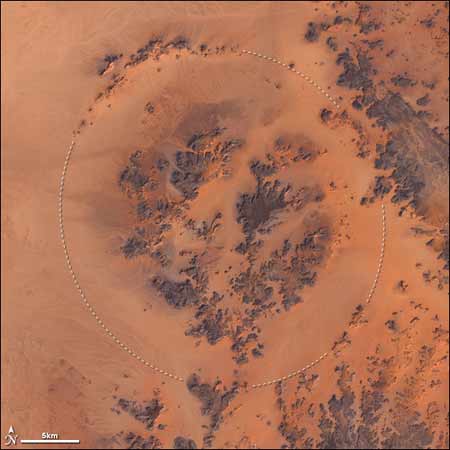In 2001, the Earth-observing satellite Landsat 7 took the above image of Egypt. Now, the dashed circle (and the blog entry title) make it pretty obvious what’s going on here, but for a moment look at the picture’s features and pretend the circle isn’t there. Now swear to tell the truth: you’d never ever see a crater in there, would you? I know I wouldn’t have.
And that’s how a crater 31 kilometers across stayed hidden: in plain sight. It’s so freaking huge no one ever noticed it before. Farouk El-Baz spotted it, but then, he has experience. He trained the Apollo astronauts in lunar surface geology (and if his name is familiar, a shuttle in Star Trek: The Next Generation was named after him).
El-Baz knew that there was a greenish glass found in Egypt called “impact glass”. It’s commonly formed when a big meteorite slams into the ground; the tremendous heat and pressure fuse the sand underneath it into glass (a big impact can dwarf a nuclear bomb in energy produced, although the temperature is much lower). So El-Baz used satellite imagery to poke around, and voila.
He has a great eye for this, obviously. Remember, he didn’t have a dashed circle to guide his view.
The raised rim is pretty clear once you see it. The impactor must have been huge, probably over a kilometer across. Anything within a thousand miles of the impact had a pretty bad day – I estimate the yield at roughly 200,000 megatons, though I might be off by a factor of two or three. For comparison the largest nuclear weapon ever detonated was about 60 megatons. The fireball would have been as hot as the surface of the Sun, and just the heat of impact would have wrought damage on an incomprehensible scale. Then the blast wave started expanding outward in a circle, and the real destruction would have begun…
The crater was immense, but a hundred million years of erosion has worn it down to a chain of hills difficult for the eye to see. Still, it sat there all that time, just waiting to get noticed. We never saw it, and it’s right here on Earth! What awaits us on other planets?’
